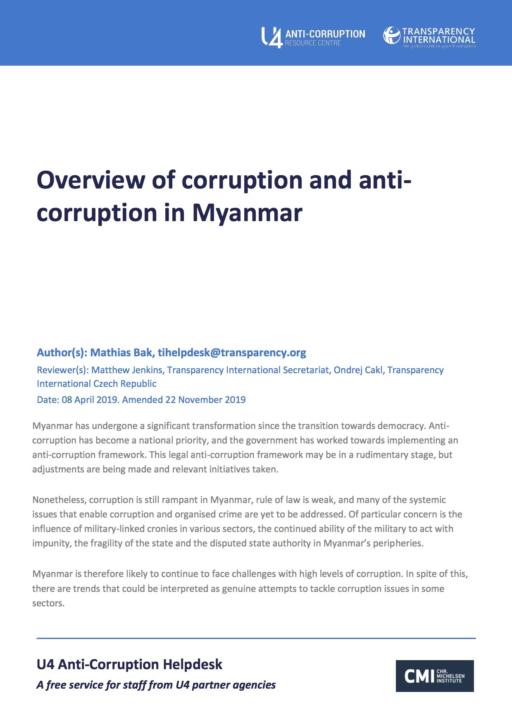
This Anti-Corruption Helpdesk brief was produced in response to a query from a U4 Partner Agency. The U4 Helpdesk is operated by Transparency International in collaboration with the U4 Anti-Corruption Resource Centre based at the Chr. Michelsen Institute.
Query
Please provide an overview of corruption and anti-corruption in Myanmar, with a focus on the justice, extractives, fisheries, education, police and agriculture sectors as well as on illicit financial flows.
Summary
Myanmar has undergone a significant transformation since the transition towards democracy. Anti-corruption has become a national priority, and the government has worked towards implementing an anti-corruption framework. This legal anti-corruption framework may be in a rudimentary stage, but adjustments are being made and relevant initiatives taken. Nonetheless, corruption is still rampant in Myanmar, rule of law is weak, and many of the systemic issues that enable corruption and organised crime are yet to be addressed. Of particular concern is the influence of military-linked cronies in various sectors, the continued ability of the military to act with impunity, the fragility of the state and the disputed state authority in Myanmar’s peripheries. Myanmar is therefore likely to continue to face challenges with high levels of corruption. In spite of this, there are trends that could be interpreted as genuine attempts to tackle corruption issues in some sectors.
Contents
- Background
- Extent of corruption
- Forms of corruption
- Sectors
- Anti-Corruption Framework
- Other stakeholders
- References
Main points
- Corruption is a widespread issue in Myanmar and is particularly worrying in the extractive industries, land management, policing and the judiciary.
- In many sectors, there are relevant initiatives to curb corruption and the legal and institutional anti-corruption framework of Myanmar is gradually improving in many respects.
- However, corruption is an endemic and systemic issue in Myanmar and there are multiple gaps in current efforts. These gaps will have to be addressed for Myanmar to continue to tackle corruption.
Caveat
To complement information available from the literature, the Helpdesk spoke with a number of academics, experts and practitioners with knowledge of governance and corruption issues in Myanmar. This Helpdesk Answer is based partly on the findings from these informal interviews. The interviews were conducted in confidence and the interviewees are not named in this answer.
Authors
Mathias Bak, [email protected]
Reviewers
Matthew Jenkins, Transparency International Secretariat, Ondrej Cakl, Transparency International Czech Republic
Date
22/04/2020

